How do Airplanes fly?

(c) Lesics Create a free SimScale account to test the cloud-based simulation platform here: https://www.simscale.com/ To perform complex …
The reason for the lift generation is not Bernoulli’s principle, it’s Newton’s 3rd law. https://youtu.be/w78JT6azrZU . More specifically, apply Newton’s 3rd law on down wash produced by the airfoil shape. Please watch the Airfoil video by Learn Engineering to understand this concept completely.
Always amazed by this technology! And huge respect to all engineers!
I was feeling a bit down tonight. For some reason watching simple, informative videos like this is comforting and brings your spirits up especially watching it late at night 🙂
I was trying to understand and then i decide to just be a passenger 😂🤣
I wish I had this video during my undergraduate Avionics degree that I completed in 1991. This video basically covers Aerodynamic 1 and Aircraft stability without the partial derivatives.
I’ve flown a thousand times and each time is an amazing experience. Airplanes, pilots and tower controllers are the greatest human intelligence, every time we take of i always close my eyes don’t wanna see the take off lol…. while i say some prayers too, but these pilot do this take off, flying and landing like its nothing, wow!!!… They are my real hero 😃✈ 😃✈😃✈
I always wondered about about the principles of physics with Flight Movement since my first flight journey and truly an outstanding contribution by the Engineers to the mankind. Proud to be an Engineer.
The 3D animations of this channel are really awesome and these animations show us the process with more detail and making these videos is not such a easy task…
Seeing all the principles from different course of study come together to achieve one goal is so exciting
Definitely made me appreciate what airline pilots do even more than I already did. Thanks for the info. Learned quite a lot of information about airplanes I’ve always being curious about.😊👍🏾
Always wondered how these giant machines take off, change directions or lose heights. So thanks for sharing such knowledge.
I was amazed after watching this video… with simple techniques the flights are flying hats off to the engineers …🛩🛩🛫🛫
Thank you for the special investment Really excellent explanation Only one very important thing you forgot to mention is that the plane depends on the atmospheric pressure and without it we can not fly at all so in outer space it will not be possible to fly a plane without other things required for this purpose…
This is one of the best explanations that I have come across.
This 8-minutes video solved all my doubts about an airplane flying. Thank you!
Fly by wire is a great technology. If added more CFD simulations this would be more informative. Specially of wings
Thank you for this amazing video!Besides from the flap and slat that still confuse me a little, I can definitely state that I finally understand most of these terms and how airplanes fly and stay stable!I’ve watched a lot of videos and some didn’t go into details like you did, so from the bottom of my heart, thank you so much! 😊Edit: I’m reading an aero book and now I’m understanding everything better!It’s so interesting
I wish I had this video during my undergraduate Avionics degree that I completed in 1991. This video basically covers Aerodynamic 1 and Aircraft stability without the partial derivatives.
It all started with an idea, then the maths and physics refined it to its present form.
I found the use of elevators, located on the back wing, near the tail, as just the missing part in my understanding of how the planes lift up the ground during take-off. Thanks for the nice explanation.
Electric cars vs Petrol cars
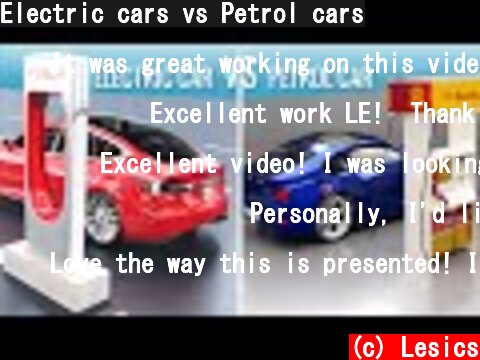
(c) Lesics Electric cars or internal combustion engine cars—which is better? Electric cars were in their heyday back in 1900, but a sudden …
It was great working on this video together, I look forward to more collaborations in the future!
Excellent work LE! Thank you for your engineering videos! I am using your electric vehicle videos in my renewable energy and EV education classes. I would also like to suggest for you to please consider doing LE videos on how photovoltaic solar and concentrated solar power systems work. Thanks again and keep up the great work!
Excellent video! I was looking for something that was strictly on the engineering differences between the two systems. Thank you
Personally, I’d like to see a future like this: There electric cars powered by batteries for those who don’t drive to much, there are hydrogen fuel cell vehicles for those that do a good bit of driving but wish to have an electric motor for propulsion, there are hydrogen gas powered vehicles (would be the replaced fuel for gasoline engines) for those who prefer Internal Combustion Engines, and there are Diesel vehicles powered that use biodiesel for fuel; in this future the consumer would have the greatest choice.
Love the way this is presented! It also feels politically unbiased which in this day and age is a bliss.Great job 🙂
I’m in med school, but damn I love watching engineering videos
Thanks for this useful video! I have 2 questions. The first question is about the effects of water when washing the whole car, particularly from underneath and the effects of rain. The second question is regarding the safety in terms of accidents; such as collision or turnover of the vehicle-what is the possibility of batteries explosion and the impact on the passengers?
I wish Tesla continues doing a great job in making the cars of the future. There is still room for improvement.
When you realize, Electric cars are actually a technology that is older than IC Engine cars
You teach lot lot lot more than what we learn in 2D at our fucking college. <3
A whole lot of topics covered in just 7 minutes great work!!
I really like the cad diagrams in these videos. It definitely helps me understand the concepts better
Great job. Only I miss contamination comparison and maintenance costs. There are important things to observe. 👍🏻
3:10 The coefficient of friction is a constant multiplier relating to tread on the tire, the road material, and the surrounding temperature. In fact, more weight would increase the amount of frictional force on the tires, giving it better traction. However, when changing magnitude, more weight will cause more inertia, consequently leading to the requirement of more difficult braking and a potential need for slower turns, but not necessarily.
Great video. The comparisons it was missing were the resale value, battery life in electric car vs. engine major repair in IC cars, and the environmental issues at scrap yard, especially with the large batteries used in electrical cars.
I’m new to the channel but this is great! Good animation combined with a clear voiceover of what’s going on. You’ve earned a new subscriber!
Your channel was useful in teaching me Force, Torque and Induction motor back in 2016. Long live this channel!!!
My gasoline car sits in my garage everyday for at least 15 hours i think am ok with one hour charge
Nice to see a comparison on performance between the two.
Dang-it! When you realize you’re driving around 100-year-old internal combustion engine technology!
SynRM | A new giant in the electrical world
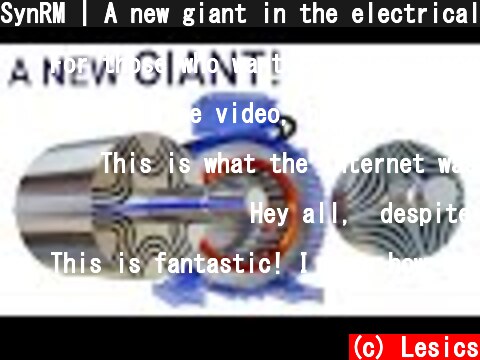
(c) Lesics With the advent of advanced control algorithms SynRMs are getting super popular across all the industries. Let’s understand the …
For those who want to delve deeper into SynRMs here are few links 1) SynRM’s potential uses in the industries – https://youtu.be/3g9lDqkCP3g 2) Interesting control logics of SynRm – https://youtu.be/ZOH1PoOOeuY 3) Torque comparison SynRm vs IMs – https://ieeexplore.ieee.org/document/1518350 4) The latest trends – https://www.plantservices.com/articles/2020/why-permanent-magnet-motors-and-reluctance-motors-are-finding-increased-industry-application/
Nice video, but as an electric motor developer I have to clear some points up, that are just not true.While the efficiency is really high, the torque output is definately not. For the high efficiency induction motors, you might be able to replace them with syncRel motors of the same size. But if you look at through-ventiled induction motors, you will not be able to match their torque with a syncRel motor of the same dimensions.Yes, Tesla uses IPM-synchRel motors. But what everyone always fails to understand is the reason behind this. At low speeds, more than 90% of the torque is due to the magnets. Only if the motor is running at high speeds, the reluctance torque becomes relevant. Looking at the design I would estimate that maybe 50 % of the torque at max rpm might come from reluctance. So what Tesla is basically doing is taking a PM motor and adding a bit of reluctance torque for better field weakening performance at high speeds.No, syncRel motors have not started replacing induction motors in most industries. That is just not true and I’d like to know where you got statement from.”For the same current input synRms are able to produce 10-15% greater torque”. While this is theoretically true in practice it doesn’t work like this due to overload capabilities. You can look up my following comparison: Let’s assume I want a 400 V 30 kW 1500 rpm motor. For both motor types it will be the same sized frame. After comparing several induction motors, the currents are ~54 or 55 A. One of the leading manufacturers of industrial syncRel motors is ABB. If you check their catalogue, you will find their motor – while more efficient – has a nominal current of 66,7 A. The overload capability is only 1,5 while the induction motors go up to 3. I will describe the reason for this below.Also here are some disadvantages of syncRel motors:SyncRel motors rely on small airgaps between rotor and stator. The rotor design is inherantly less stable than that of an induction motor. Therefore it is a terrible choice for high speed applications.For through-ventilated motors at medium speeds (lets say ~3000 rpm) an induction motor will be much smaller and therefore have a much smaller inertia.Another factor often overlooked is the terrible overload performance. While normal IE3 induction motors can easily have breakdown torques of 3x the nominal torque, this is unthinkable for syncRel motors. This is because their back EMF depends on the load. So if you want to design a 400 V syncRel motor for short 200% overloads (this is more common than you might think). Not only would you need a larger motor, you can only run it nominally with 200 – 300 V, meaning that your nominal current would be highly increased. So the losses you save would be massively outclassed by higher losses in the stator. Induction motors on the other hand can just run nominally at 400V and still have lots of overload capabilities. This is also why you should not use pure syncRel motors for traction or electric vehicle applications. In these applications you want very high overload capabilities.But even after all my banter, syncRel motors still have their place. They are well suited to continuously operate fans and some types of pumps, which require no overload capabilities. In these cases the efficiency can be increased by switching from induction motors to syncRel motors.I know this was a bit long, but hopefully I was able to bring across my points.As electric motors are my passion, I am happy to answer any questions you might have.
This is what the Internet was meant for. These videos are solid gold for anybody trying to keep up with technology.
Hey all, despite some exaggerated claims here, I have to say as a professor of technology and professional electrical engineer that the video presentation is nevertheless very good and informative overall. I’m impressed, great 3D animations too (I know, I use Blender for my stuff). From my studies, I’m not seeing too many applications using these motors past 30HP. They are primarily used in lower power fans, pumps, and conveyor systems were the energy savings relative to similar sized induction motors, especially at reduced speeds, warrants their inclusion. Where large numbers of motors are used in a building or plant environment in this HP class, dollar savings could add up and companies like Siemens and ABB are boasting new product lines using these. This has been largely driven by green initiatives under European directives and elsewhere. Reluctance motors is not a new concept, merely one that has come of age with the advent of microprocessor solutions for stator control that did not previously exist but reluctance in itself is self limiting and never as strong as having a second rotor magnet, either due to induction or a separately supplied DC exciter, as in a synchronous motor with a field.That’s why for larger motors in the hundreds of HP, the induction motor and field excited synchronous motor, or traditional DC motor, or BLDC, will remain the kings for some time to come. Once you’re into say 100HP and up, I don’t think you’re going to see this motor type in a large way any time soon and as one of your previous commentators pointed out, an induction motor can be designed with 200% to 300% pull-out torque. Good luck getting that with a reluctance type motor. Everything has its pros and cons, all we’re doing now in technology is trading one set of advantages for another but never getting everything we want in one design – that’s physics.
This is fantastic! I love how these motors also don’t use any rare earth magnets. Remember when China decided to mess with Japan during one of their periodic bouts of grievance, and cut off Toyota’s access to rare earth magnets for their hybrid car motors? That was a huge wake-up call that a rare-earth-free motor of at least comparable performance had to be developed stat. I’m really glad that the most efficient motor also is the most mechanically simple, and doesn’t depend on some rare element. The importance of this last point can’t be over-stated. This is an absolute game changer.
Sounds like this is basically a reluctance based synchronous motor, where as most synchronous motors usually use permanent magnets in the rotor. Maybe the best would be a hybrid concept with permanent magnets AND optimized reluctance (like it is done in hybrid stepper motors).
You guys explain it very simply and by using good softwares like solidworks… With lot of hardwork… My gratitude to your team.👏👏
Loved the explanation of how the motor works. From what I understand, there are still advantages to induction motors which is why Tesla still use both (different torque, power & efficiency curves).-SRM advantages seem to have efficiency (which is still only a couple % higher than induction), but the rotor can be significantly cheaper to make and from what I understand more power dense.-SRMs actually still aren’t very common. In fact, I would say induction motors will continue to rule domestic as they’re very cheap, efficient & durable when powered by AC mains (as they don’t need expensive controllers when the source is AC). While small/RC motors or battery powered motors will probably remain as PM or brushless PM, as they are incredibly power dense and easy to control.SRM is definitely my fav thoughxD
This is exactly what I was missing. Finally some engineers gave it a little thought. Tricks with magnetic fields. I’m so glad there is finally this. A good rotor. Took some time. Glad it’s here.
Thank you for validating my experience and helping me to start to understand I’m not crazy, this technology is really here and some of us have already been exposed to the experimenting aspect of the project, without consent or without permission.
I designed and installed many industrial projects where I applied a variable frequency drive to an existing induction motor to match the motor output to a varying load. Many of these projects involved pump applications and the motors were typically on a multiple motor manifold. The motors were typically 50 to 250 hp, 480 volt, 3 phase and up to 5 motors on a manifold. This approach provided a typical payback of 2 to 3 years. The power output of a motor has a squared relationship to the speed; at 70% speed the motor consumes about 50% of full load power. Replacing the induction motor considering the cost of the motor and the labor to replace it would run the cost through the roof and extend the payback past where most industrials would not make the investment. In business, the cost vs savings is always in the forefront of the decision.I also installed equipment with large servo motors as part of the process. The servo motors had permanent magnets in the rotor and a rotating field in the stator and were able to start and stop on a dime and display incredible acceleration and braking. I imagine this type of motor would be more expensive than the SynRM motors but have torque and performance benefits.
Super video! Think about how they eliminate all that copper on the rotor … I’m guessing that copper is in the motor housing now but sure does seem like a lot less maintenance. Thanks for sharing
So amazing, very good animations and very clearly explained.
This video does an amazing job of explaining reluctance motors. Also I love MrZauberwuerfel’s comment on some of the nuances and specifics that this video might have missed. I do not know his qualifications, so I cannot vouch for their voracity.
The video almost seemed like a sales pitch for SRMs. My first thought was: if SRMs are so good, then why aren’t they replacing induction motors everywhere? But reading the many comments answered that question pretty quickly.
Absolutely brilliant…well explained…Love this sort of tutorial..College days👍👏👏
Outstanding lesson! Thanks for the information.
Great video, many people in this industry don’t know and don’t see the shift towards these motors. With advanced switching capabilities of today these motors become a very interesting choice.
this was very comprehensive and educational. but i was missing a bit of information, on what properties set this new technology apart from other modern motor designs, in preactical use.one economical benefit i see over the classic “brushless outrunner”, which can pack extreme wattages in a very small and light package* (2-3kW in the palm of your hand!), is that this technology doesn require expensive rare earth permanent magnets. which also makes the production independant from importing rare ressources that are often mined under awfull conditions.( * = those mostly find use in drones and small electric vehicles, often as direct drive hub motors, because they can produce a lot of torque )
A helpful explanation. Thank you and +1. 👍QUESTION: So, why dont they improve the design by adding feedback sensors to accomodate hysteresis DYNAMICALLY as RMF increases ? It seems to me that by rapidly over and undershooting the optimal EM current by very small amounts in alternation, a good computer program should be able to optimize the timing to further enhance efficiencies across a wide range of speeds during a break-in calibration interval, and then remember those setting to enable rapid response thereafter. Am I just anticipating control logistics that have already occurred elsewhere ? I do that a lot. 😉On an unrelated note, do you have any updates or metamaterial advances to report in the realm of thermoelectrics ? That would have a huge impact on a wide range of important tech.
How does a Steam Turbine Work ?
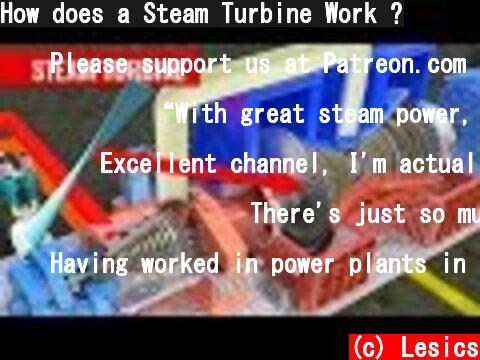
(c) Lesics Please support us at Patreon.com so that we can add one more member to the team and will be able to release 2 educational …
Please support us at Patreon.com so that we can add one more member to the team and will be able to release 2 educational videos/month.https://www.patreon.com/LearnEngineering
“With great steam power, comes great steam efficiency”
Excellent channel, I’m actually sharing a lot of these videos with my engineering degree students. Regards
There’s just so much detail in a video of such short duration, makes it a treat to watch. Our prof shows your channel’s videos in class and god knows I have fallen in love with the content.
Having worked in power plants in Ireland and overseas, I find this video very interesting when you consider the amount of equipment involved boilers, fuel, water treatment, cooling systems and power distribution.
Great video!! As a kid I’d always stare at pages of pictures showing these intriguing mechanisms in lots of science books! Had a huge fascination for turbines!
I’m so happy to learn something new today, this video is so cool! This channel does an amazing job! Thanks guys!
Amazing tutorial :fantastic experience.Thank you❤️
You did a better job of explaining this clearly than my professors used to, I really wish I stumbled upon this channel earlier.
Very nice video. Just one more thing. In modern coal power plants with Benson boilers the temperature of primary stream is about 610degrees and reheated stream is about 630degrees. Seems a quite small difference but increases the efficiency of unit from 36% to 45%.
Sir it was indeed an awesome video, but we expect u to explain the entire process right from boiler outlet to electricity generation for much vivid understanding. Thanks !👌
I’m a chemical engineer and this video is so easy to understand. Great Video!
by far this is the most effective video i have seen related to steam turbine…great work
But, if in the path of the steam (between the turbines) and it loses the physical characteristics mentioned, that sense has two types of blades repeated many times in equal form.The logic would dictate to vary the forms of the blades, both to progressively enlarge them (a blade group) and to diminish them in a de-progessive way (the next group of blades).But we need a design that is measured in its variability to optimize the whole physical-mechanical process.And then the turbines have neither the variable pitch nor the variable geometry of the blades that must rotate on themselves.
I am an A level science student in Bangladesh ( its called class XII in Bangladesh, just mentioned the A level stuff for easy reference). According to my understanding, a modern steam turbine is fairly complicated. So much so that you have to study the angle of the airfoil, twist in the blades, the proportion at which the blades get larger, pressure regulation mechanism, maintenance and finally the overall efficiency.ALL THE FICTIONAL NOVELS AND STORIES ABOUT OTHERWORLD TRAVELS (Isekai) FEATURES MAIN CHARACTERS WHO DIDN’T EVEN STUDY ENGINEERING TO BUILD A STEAM ENGINE FROM THE GROUND UP. LIKE HOWWWWWWW??!! ( If you understand what I’m saying)
Very interesting. I would add something about regenerative operation along with reheating. But this was entertaining and beautiful. Thank you!
Great video. Though, there is something I must nitpick. You say that ΔEnthalpy is ΔEpressure + ΔEtemperature. That may be Gibbs energy, whose equation is G=U+PV-TS, where U is the internal energy of the fluid (ie chemical energy and energy due to height), P is the pressure, V is the volume, T is the temperature and S is entropy. Enthalpy is only H=U+PVhttps://en.wikipedia.org/wiki/EnthalpyAlso, I do not understand the purpose of this DOR number. What is it ? You also say that you obtain DOR by dividing Gibbs energy by the total energy change during the fluid’s passage through the turbine. How do you calculate this energy ?
great video ! keep going your amazing work !btw I’m trying to enter into the DIY world 😊
Great video, will suggest it to classmates👌Explained the basic idea very clearly.
I really like these kind of videos, about to get into 3d software development and I hope this type of device is the first thing I build inside of it.
How does a Stepper Motor work ?
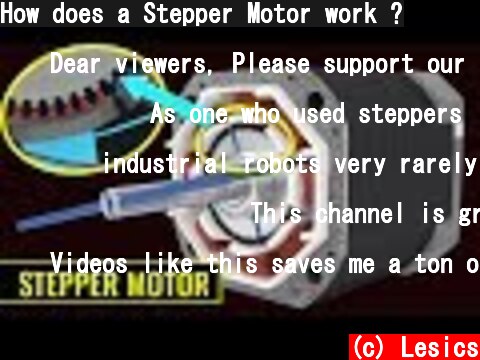
(c) Lesics We thank our patrons for making LE’s educational service sustainable. Please support us at Patreon.com so that we will have the …
Dear viewers, Please support our educational service at www.patreon.com/LearnEngineering . Your support will enable us to release 2 videos/month.
As one who used steppers in my CNC, it is VERY interesting to see the design intent contained within.
industrial robots very rarely using stepper motors. servos are much more common…also industrial machines NEVER use open loop system. they rely heavily on position encoders…
This channel is great, always something actually new to learn! Other channels just cover the same old stuff I worked out as a kid (lift, basic electricity, basic powerplant etc).
Videos like this saves me a ton of hours learning.. Keep the great job
An amazingly explained video, you guys earn every penny that goes to your patreon.
Brilliantly explained and finally I understood how,what & why of Stepper motors and its applications.thanks
Thank you for making such a great video!I understood the first motor though I didn’t get how exactly the more common one works however I got some intuitive understanding of how they work.. thanks
PERFECT explanation as always. Thanks!
You guys are just amazing. Every time I click on your videos, I just know I’m gonna learn something and that too in a simplest way possible. Thanks y’all. ❤
Great video! Thank you, sir! May I ask a question, in my Chinese textbook, there is a formula: /theta = /frac{360}{m*Z*Q}, where theta is the stepping angle, m indicates the number of phases, and Q means the number of beats per a single period. So in the last hybrid motor example, the Q=1, m=4, is it right?
MUITO BOM ,DEU UMA VIS�O BEM TRANSPARENTE DO FUNCIONAMENTO DO MOTOR DE PASSO!
Thanks Lesics team, you have an amazing art to teach typical things easily.
This video was fantastic, and very well done. Thank you for the very clear explanation.
Thank you for everything! At first I was skeptical of the slowness of your explanations. Now I appreciate that!
very nice. the theory was great, regardless of others comments. easy to grasp for non engeneer/teckie types.
Amazing. Your videos just send big doses of adrinaline in my blood and make feel as though am the one who created all that technology. Thanks a million for the knowledge
The clarity of the explanation reflects the depth of your knowledge. Your graphics team has worked hard too. You deserve every penny you get. Well earned!
Great video. Whoever invented the stepper motor is a genius.
excellent videos.each video covers all important concepts of a particular machine. animation and explanations are pretty good.kindly upload more videos on special electrical machines
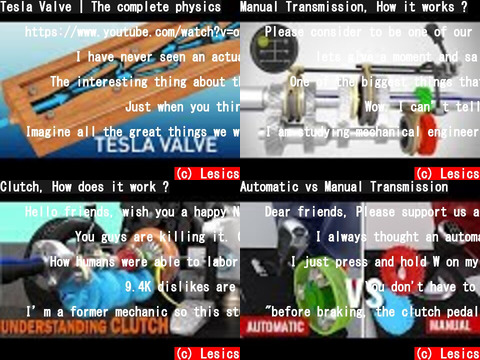













![岡田斗司夫 [切り抜き] 編集ちゃんねる(Youtube 動画 pick up)](https://imitoha.com/c/imgc/UCwfyW7i8kAFUj8_tSSDT_PA/-a-input.jpg)









コメント